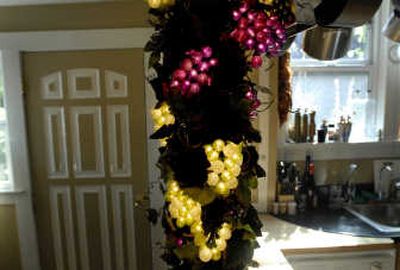Playing with history

From the outside, Professor David Giese’s boxy home looks like the others in his Moscow neighborhood. Dark brown siding. Well-tended gardens. Fun bits of art and fancy.
Inside is another, more European, story. “Ornate,” comes to mind.
It’s “intimately grand,” Giese said, and reflects a style he calls “Cottage Baronial.” Wallpaper that would look at home in a European manor brings color and warmth to the entry way. Elegant accessories decorate antique end tables. Frescoes adorn the carefully painted cocoa brown walls in the living room.
At first blush, the frescoes seem to be very old, with jagged, broken edges and chips in the stone – like something found in a ruined Roman villa. A careful look with a trained eye will reveal something a little bit off about the frescoes.
The large piece over his fireplace, “The Celebration of Flora,” for instance, is a collage of three different historical paintings. The column along one edge is reflective of the late 18th century. Another figure underneath is 19th century. The cherubs are copies of mid-18th century pieces.
Turns out the frescoes are as faux as faux can be. Giese made them all in his University of Idaho studio.
“What I was trying to do was not necessarily to fool people. What I was interested in was confronting the viewer with their own sense of knowledge,” he said. “So, like a revisionist historian, I just make up things as I think they should be.”
The result is that people with very little background in art history can appreciate the object for its beauty. “While other people with a little more knowledge can begin to realize how impossible these things are,” he said.
Giese, now in his 30th year teaching painting and multimedia at UI, developed an innovative technique to create his pieces.
He finds an image he likes, scans it into a computer, then blows it up and manipulates it as needed. Then he uses a special chemical process to transfer the images on to a pre-formed concrete fresco.
The concrete itself is unique, too. It’s made especially for Giese and is similar to the materials used to repair freeways. The concrete is cast only 1/4-inch thick, but is able to withstand great pressure. The rest of the structure is filled with expandable foam.
The technique arose out his graduate work; Giese has two Masters of Fine Arts degrees, in photography and ceramics. He became fascinated, he said, with the idea that objects often seem more beautiful when aged – even if artificially aged – than when new.
He uses the technique to craft more than frescoes. His backyard, with its elaborate flower gardens and patios, features a large grotto fountain that climbs up the wall of a detached garage. The fountain water collects in large tub that’s crafted using his cast concrete technique.
It’s certainly the eye-catching centerpiece in his eye-catching garden. “You can’t believe you’re in Moscow, Idaho,” he said.
Giese also has created some large-scale projects for clients in Las Vegas, including an outdoor fireplace and a Roman-style spa.
His home decorating earned him some national attention this year when the HGTV show “Look What I Did!” filmed a segment in his house. The show originally appeared in July. His work was also featured in December in an exhibit at the OK Harris Gallery in New York City.
“I really like the idea that (my work) accommodates a lot of different people at different levels,” he said. “My work is in some ways very believable, but it’s actually an impossible construct that would never have existed historically in art.”